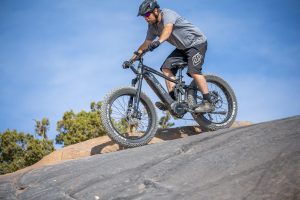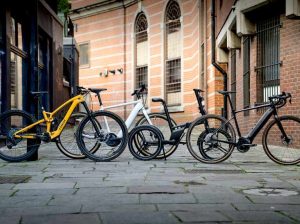To increase your electric bike range, maintain optimal tire pressure, manage battery life, and adopt efficient riding habits.
Battery Management for Optimal Range
Good battery management is critical for maintaining and extending the range of your electric bike. By understanding and implementing effective charging strategies, you can ensure that your battery retains its capacity and health over time, translating into more miles on the road.
Maximizing Battery Life
To maximize the life of your electric bike’s battery:
- Avoid Extreme Temperatures: Store and charge your battery in a temperature-controlled environment. Extreme heat or cold can degrade battery cells.
- Maintain Charge Levels: Keep your battery’s charge between 20% and 80% to promote longevity. Fully discharging or charging to 100% can strain the battery.
- Regular Use and Charging: Regularly using and charging your battery prevents stagnation, which can reduce battery life.
- Proper Long-Term Storage: If storing your e-bike for an extended period, leave the battery at a mid-level charge and recharge it every few months.
Charging Techniques and Tips
Charging techniques can also have a significant impact on your e-bike’s range:
- Use the Right Charger: Always use the charger provided with your e-bike or one approved by the manufacturer to prevent damage.
- Charge After Riding: Allow your battery to cool down before charging, especially after extensive use.
- Monitor Charging Time: Avoid overcharging by unplugging the battery once it’s fully charged.
- Smart Charging Devices: Consider investing in a smart charger that automatically stops charging once the battery is full to prevent overcharging.
Riding Habits and Range Efficiency
Adopting efficient riding habits is essential for maximizing the range of your electric bike. Each element of how you ride can influence the amount of power you consume and thus the distance you can travel on a single charge.
Pedal Assist vs. Throttle Use
Understanding when and how to use pedal assist versus throttle can greatly affect your e-bike’s range:
- Leverage Pedal Assist: Engage pedal assist to contribute to the bike’s motion, which can increase range by up to 15% compared to using the throttle alone.
- Moderate Throttle Use: Use throttle sparingly, especially when starting or climbing, as it can draw significant power. Maintaining a steady speed consumes less energy than frequent acceleration.
- Select Appropriate Assist Level: Choose a lower level of pedal assist for longer rides to conserve battery power. Higher levels can consume power at a rate that might reduce the overall range by as much as 30%.
Efficient Riding Techniques
Efficient riding techniques can enhance your e-bike’s range significantly:
- Maintain Steady Speed: Aim for a consistent pace. Variable speeds can increase power consumption by up to 20%.
- Plan for Terrain: Anticipate changes in terrain. Use momentum to coast uphill and reduce power usage.
- Reduce Weight: Lighten your load. An extra 10 pounds (4.5 kilograms) can decrease your range by as much as 5%.
- Aerodynamic Posture: Adopt a more aerodynamic position when riding. Reducing drag can improve energy efficiency by up to 10%.
Accessory Use and Energy Consumption
Selecting and using accessories on your electric bike impacts its overall energy consumption. Being mindful of what accessories you add and how you use them can play a significant role in how much range you can get out of a single charge.
Identifying High Energy-Consuming Accessories
Some accessories draw more power than others, and identifying these can help you manage your energy use:
- Lights: High-power LED lights can consume a lot of energy. For instance, a set of 10W LED lights running for 5 hours can use 50Wh of your battery’s capacity.
- Electronic Gear Shifters: These can draw a significant amount of power for operation, with some models using up to 20Wh per day depending on usage.
- Heated Grips: Especially in colder weather, heated grips can drain the battery faster, using around 15-30W of power.
Smart Accessory Management
Smart management of your e-bike’s accessories can lead to more efficient energy consumption:
- Prioritize Necessity: Only use accessories when necessary. For example, turn off lights during daytime riding.
- Invest in Efficiency: Look for energy-efficient accessories. LED lights, for example, offer more lumens per watt compared to other types of bulbs.
- Regular Maintenance: Keep accessories in good condition to ensure they operate at peak efficiency.
- Accessory Integration: Choose accessories that can be powered by the e-bike’s main battery rather than separate batteries to streamline energy use.
Tire Selection and Pressure Optimization
Choosing the right tires and maintaining the correct tire pressure are key factors in maximizing the range of your electric bike. Tires significantly affect the rolling resistance, which in turn influences how much power your bike needs to move forward.
The Impact of Tires on Range
- Rolling Resistance: Tires with low rolling resistance improve range. For example, some road tires can decrease rolling resistance by up to 20% compared to standard tires, which can translate to an increase in range.
- Tread Pattern: Smooth treads are best for paved roads and will use less energy. Knobby treads, intended for off-road use, can reduce range by increasing resistance.
- Tire Width: Narrower tires generally have less rolling resistance than wider ones. A 1-inch wide tire can save up to 5% in energy over a 2-inch wide tire at the same pressure.
Maintaining Optimal Tire Pressure
- Pressure Checks: Regularly check tire pressure. Tires underinflated by just 5 PSI (pounds per square inch) can increase rolling resistance by 10%.
- Correct Inflation: Inflate tires to the manufacturer’s recommended pressure, which is often between 40-70 PSI for e-bikes, to ensure optimal performance.
- Pressure Gauges: Use an accurate pressure gauge to maintain consistent tire pressure. A variance of 2 PSI can lead to noticeable differences in range and handling.


